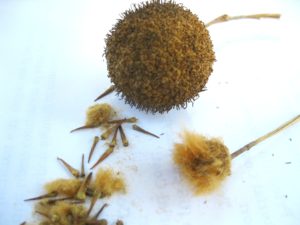Name: American Sycamore
Botanical Name: Platanus occidentalis
Form: large tree
Parts Used: seeds
Citation: Guenther, K. (2017, February 12) American Sycamore as wildlife food [Web log post.] Retrieved: readers supply the date, from http://wildfoods4wildlife.com
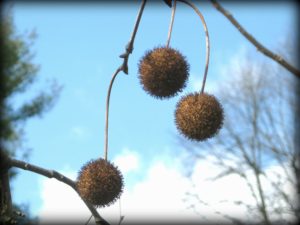
Getting Started
Sycamore seed ranks 35th on our Super Seeds list. Picture the tree’s limbs hanging over water and the seed falling and floating downstream. Sources show that sycamore seed is eaten by beaver and muskrat. So, I always expect sycamore seed might also be eaten by waterfowl, but I have not found that referenced. Nonetheless, when I make a waterfowl seed blend, I add in some sycamore seed if I have it on hand. It is the same size and shape as buttonbush, a known waterfowl food of the same streamside habitat.
Platanaceae (Plane-tree family)
Platanus ( Sycamore genus)
| Common name | Virginia Platanus Species | Origin | Rare Plant Status |
| Sycamore, American | P. occidentalis | native | not rare |

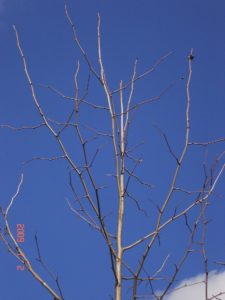
Key Features to Look For
In addition to the identification guide of your choice, here are a couple of features you should see on this tree:
- Gray peeling bark in the upper half of the mature tree, revealing the bone-white trunk
- Large, maple-shaped leaves, the size of your hand up to the size of a dinner plate
- Ping-pong sized seed balls hanging on long stems like ornaments fall through winter
- Tree is likely to be in the vicinity of a stream, pond or wet low area, or floodplain
- Massive tree
Risks
No indication of risk associated with animals eating seeds.
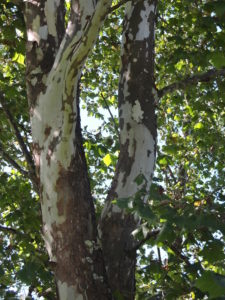
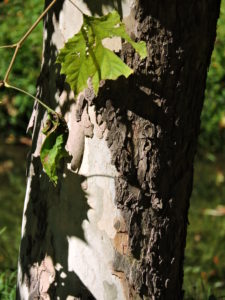
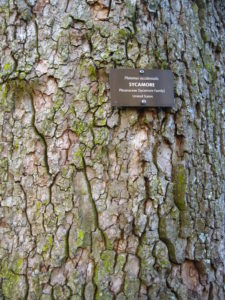
About This Species
This is one of our largest trees, beautiful and graceful. I have one near me I think of as Grandmother Sycamore. In winter, the peeling gray, thin bark sheds to reveal the bone white trunk underneath—one of the easiest ways to identify sycamore in any season. Sycamores grow near water, so when you see a row of them in the distance, they’ll probably lead you to a pond or creek.
Flower Description: Flowers bloom when the leaves come out and look like smaller red versions of what will become the fall seed balls. The female flowers are red and the male flowers are yellow, on the same tree. The flowers are not showy and are easy to miss. Sycamore is a monoecious tree with male and female reproductive parts on the same tree, allowing self-fertilization.
Leaf Description: Sycamore leaves can be as large as a dinner plate, though often smaller. They have a wonderful distinctive smell in early fall when first drying in the sun. Visually, they remind me of maple leaves. At the point the leaf stem meets the leaf, on the underneath side, is flared, enlarged and indented into the shaft of the stem. Leaves are alternate and simple.
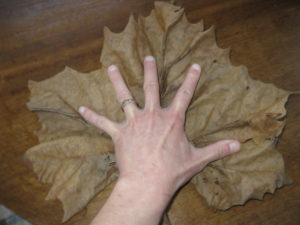
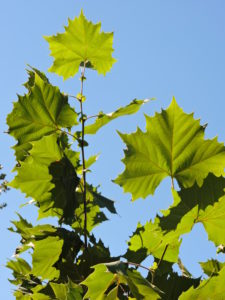
Seed/ Fruit Size: Seed balls are 1-1/8 inch (3 cm) round, just a little smaller than a ping pong ball covered with perhaps a hundred individual achenes— hard, dry single seeds. The seeds attach to a long 3-1/2 inch (9 cm) stem (petiole). An individual seed is 3/8 inch long by 5/64th inch wide (9 mm by 2 mm) and shaped like a railroad spike. The seed balls can be seen hanging on trees by November but the seed doesn’t mature and drop until late winter and spring. A similar look-alike seed ball–Sweet gum– has a similar size seed ball, but a much rougher exterior texture.
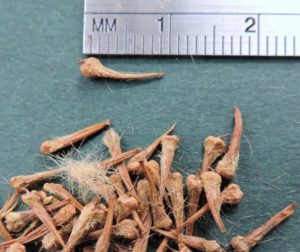
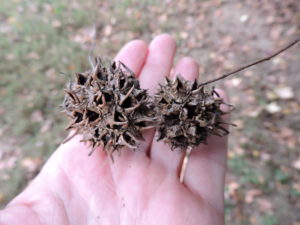
Harvest
| Jan | Feb | Mar | Apr | May | Jun | Jul | Aug | Sep | Oct | Nov | Dec | ||||||||||||||
|---|---|---|---|---|---|---|---|---|---|---|---|---|---|---|---|---|---|---|---|---|---|---|---|---|---|
| winter | winter | late winter | early spring | spring | late spring | early summer | summer | late summer | early fall | fall | late fall | ||||||||||||||
| seed | x | x | x | x | x | ||||||||||||||||||||
Is this a good enrichment item? Possibly. You can try harvesting a low hanging branch with the seed balls still attached and intact and install the branch in an enclosure.
However, if you are offering the seeds still attached to browse for squirrels or other mammals, they might be tempted to also eat the leaves. Leaves of cut browse of Sycamore could possibly be a cyanide risk according to research done by Kevin Aikman. Read his thesis here. Browse with seeds for birds would not be an issue. Birds are susceptible to cyanide, but do not eat leaves.
If the seeds are ripe enough to eat, then they will also be fragile to bumping, so handle the bough gently to cut, transport and install. If the seed balls are not at all fragile to touch, they probably are not ripe enough, and may not ripen further after cutting.
Harvesting Seeds
Seed balls hang on the tree through winter like ornaments. It is best to harvest in late winter or spring. The ball will crumble and disperse seed come spring when the big winds blow. Sycamores are tall trees, so you’ll need to find a tree with low branches if you want to harvest directly off the tree. And you will have to use scissors to cut the fibrous stem (petiole) of the seed ball if you don’t want to wait for the balls to fall to the ground later. Just make sure the seed does come easily off the ball–that the seed is mature.
Often, if you time it right, you can collect the seed when it is on the ground and the ball is still somewhat intact. I get a decent amount of finished seed off of 10-15 sycamore seed balls, about 2 cups. Let the seed balls drying inside a few weeks, then pick a breezy, dry day outdoors to clean the seed. It is a dusty affair of fine hairs—I strongly recommend you wear a dust mask. Break open the balls with your thumbs and separate the seeds until they are loose from the center orb. This creates a lot of inhalable dust hairs from the chaff. Stand upwind of your bowl!
Once the seeds are in the bowl, take up a golf ball size mass and rub it around in your hands. The seeds dislodge somewhat easily from the fluff and fall into the bowl along with a lot of dust. Do a few rounds of vigorous rubbing of the seeds. Periodically winnow off some of the dust in a breeze. Shake the bowl to let the seeds settle and the fluff will rise to the top and you can hand pick it out and discard. At some point, I find it helpful to shake the seeds through a colander to further separate from the fluff. It is a combination of rubbing, picking, sifting and winnowing through the batch until the seed is as clean as you want it.
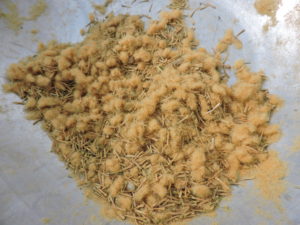
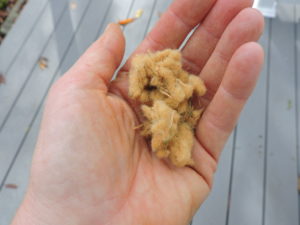
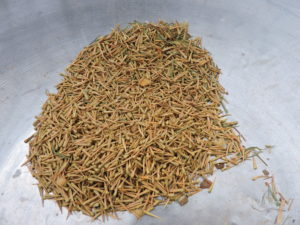
How to Store Prepared Seed: Once cleaned and fully dried, choose a low humidity day—not a rainy day—to jar up your seed.
Glass or metal works best, because all plastics are somewhat porous to humidity. Canning jars and lids work well. Place seed in a tightly sealed, glass container and store in a dark, cool area for up to 1 year. Refrigeration and freezing work well. Label the airtight container with the seed name, date of harvest and which animals it should be used for.
If you intend to keep the seed longer than one year, jar up the seeds in two stages. First, jar the seeds up using a desiccant for up to 1 week. Then check the seed for dryness, and if dry enough, remove the desiccant and immediately repack the seed into an airtight container.
Keep stored seed in an airtight glass or metal container in a cool, dark place. Refrigeration and freezing works well, but allow container to warm to room temperature before opening. Discard any seed that ever appears moldy. See instructions.
Feed American Sycamore to:
sycamore, American | (Platanus occidentalis) | seeds |
|---|---|---|
Beaver, American | Castor canadensis |
|
Muskrat, Common | Ondatra zibethicus |
|
Squirrel, American Red | Tamiasciurus hudsonicus |
|
Squirrel, Eastern Fox | Sciurus niger |
|
Squirrel, Eastern Gray | Sciurus carolinensis |
|
Chickadee, Black-capped | Poecile atricapilla |
|
Chickadee, Carolina | Poecile carolinensis |
|
Crossbill, Red | Loxia curvirostra |
|
Crossbill, White-winged | Loxia leucoptera |
|
Finch, Purple | Carpodacus purpureus |
|
Goldfinch, American | Carduelis tristis |
|
Junco, Dark-eyed | Junco hyemalis |
|
Oriole, Baltimore | Icterus galbula |
|
Redpoll, Common | Carduelis flammea |
|
Siskin, Pine | Carduelis pinus |
|
Book References:
Martin, A.C., Zim, H.S., Nelson, A.L. (1951). American Wildlife and Plants: A Guide to Wildlife Food Habits. New York: Dover Publications.
Scott, M. (2013). Songbird Diet Index. National Wildlife Rehabilitators Association, St. Cloud, MN.
On-line References:
Aikman, Kevin E.,( 1987, January 1) Cyanogenic Plants of Illinois. Masters Theses. 2580. Retrieved July 17, 2017 from http://thekeep.eiu.edu/theses/2580
Sullivan, Janet. 1994. Platanus occidentalis. In: Fire Effects Information System, [Online].
U.S. Department of Agriculture, Forest Service, Rocky Mountain Research Station, Fire Sciences Laboratory (Producer).
Available: http://www.fs.fed.us/database/feis/ [2017, February 16].
USDA, NRCS. 2015. The PLANTS Database (http://plants.usda.gov, 24 November 2015). National Plant Data Team, Greensboro, NC 27401-4901 USA.
Virginia Botanical Associates. (Accessed November 2015). Digital Atlas of the Virginia Flora (http://www.vaplantatlas.org). c/o Virginia Botanical Associates, Blacksburg.

